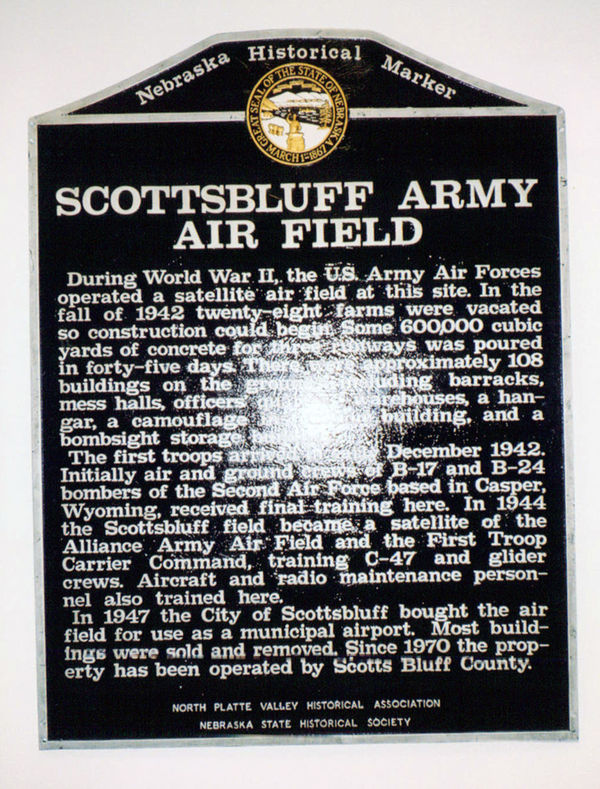Nebraska Historical Marker: Scotts Bluff Army Air Field
Location
Apron Dr, Western Nebraska Regional Airport (BFF), Scotts Bluff County, Nebraska
View this marker's location 41.869937, -103.5942
View a map of all Nebraska historical markers, Browse Historical Marker Map
Marker Text
During World War II, the U.S. Army Air Forces operated a satellite airfield at this site. In the fall of 1942 twenty-eight farms were vacated so construction could begin. Some 600,000 cubic yards of concrete for three runways was poured in forty-five days. There were approximately 108 buildings on the ground including barracks, mess halls, officers' quarters, warehouses, a hanger, a camouflage instruction building, and a bombsight storage building. The first troops arrived in early December 1942. Initially air and ground crews of B-17 and B-24 bombers of the Second Air Force based in Casper, Wyoming, received final training here. In 1944 the Scottsbluff field became a satellite of the Alliance Army Air Field and the First Troop Carrier Command, training C-47 and glider crews. Aircraft and radio maintenance personnel also trained here. In 1947 the City of Scottsbluff bought the airfield for use as a municipal airport. Most of the buildings were sold and removed. Since 1970 the property has been operated by Scotts Bluff County.
Further Information
Before the Scottsbluff Army Airfield came into existence, Scottsbluff was home to a municipal airport built in 1934. In 1942, the city prepared a document saying that Scottsbluff would be ideal for a military airfield. The Army agreed and began building the Scottsbluff Army Airfield on September 7, 1942. To make way for the new field, 28 farms were purchased. The municipal airport was closed and later became a prisoner of war camp. Originally a satellite of the air base in Casper, Wyoming, the field was first occupied on October 11, and troops began to come to the base on December 4. Troops stationed at Scottsbluff trained using B-17 and B-24 bombers. In 1944, the field was transferred to the Troop Carrier Command and became a satellite of the Alliance AAF. After the switch, the field was used for C-47 transport planes and gliders. In 1947, the airfield was sold to the city of Scottsbluff. It became a municipal airport, but was still used for military training exercises until 1950. In 1970, Scottsbluff transferred ownership to Scotts Bluff County. The airfield is now called the William B. Helig Field. Of the 108 buildings at the site, only 6 now remain. No fatal air crashes occurred involving planes originating from Scottsbluff AAF. The only fatality related to the field was an airman who intentionally jumped out of a flying plane without a parachute.
Bibliography
Goeres, Vince. Wings Over Nebraska: Historic Aviation Photographs. Lincoln: Nebraska State Historical Society Books. 2010.
Kooiman, Barbara M. Aviation Development in Nebraska. Nebraska State Historical Society State Preservation Office and Nebraska Department of Aeronautics. Mississippi Valley Archaeology Center at University of Wisconsin-La Crosse. 2000.
Penry, Jerry. Nebraska’s Fatal Air Crashes of WWII. Milford: Blue Mound Press. 2009.
Marker program
See Nebraska Historical Marker Program for more information.

